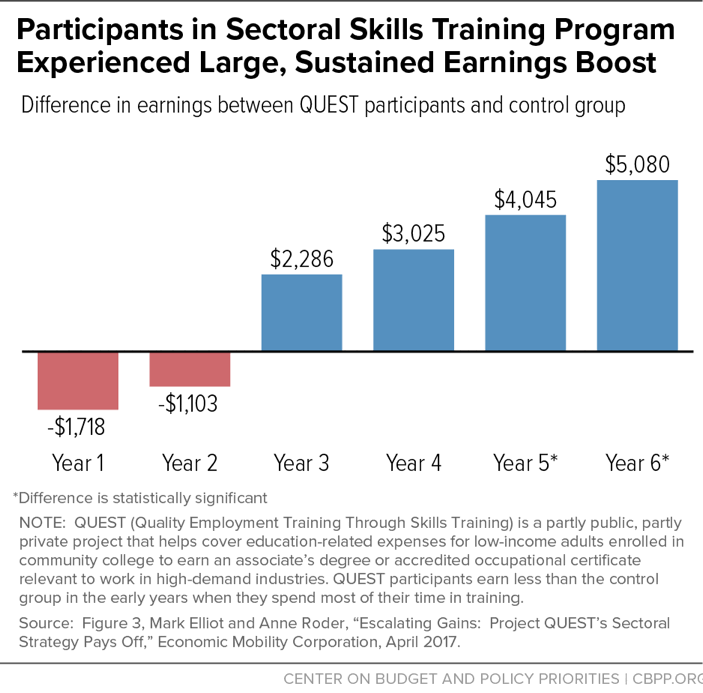Sectoral-based skills training programs that offer work-related supports can yield sizeable, sustained gains in employment and earnings for low-income workers with the most difficulty finding jobs, the Economic Mobility Corporation’s rigorous evaluation of Project QUEST finds.[1] As cities continue adapting to the economy’s decades-long shift from manufacturing to service- and technology-driven sectors, public investments in programs that boost economic mobility and prepare workers for in-demand industries are crucial.
This is the latest study in a large body of research showing that skills training and subsidized employment programs can boost earnings and employment for hard-to-employ workers trying to gain a foothold on the economic ladder.[2] The QUEST evaluation stands out, however, for its sustained results six years after program enrollment. Previous evaluations of sectoral-based training programs only studied results after two years, providing no insight on whether the gains would fade after that point, as occurred in some other job training programs.[3]
Based in San Antonio, Texas, QUEST (Quality Employment Training Through Skills Training) is partly city-funded and provides financial aid to cover education-related expenses for low-income adults enrolled in community college to earn an associate’s degree or an accredited occupational certificate. As a sectoral training program, QUEST targets degrees and certifications that prepare its participants to work in high-demand industries that pay family-sustaining wages and offer advancement opportunities. But unlike most sectoral programs, which tend to target occupations within a single industry, QUEST supports training in occupations across multiple sectors, including but not limited to health services and information technology.[4]
QUEST also provides intensive services to help ensure participants stay in school and finish the training. This includes direct services — including remedial instruction, basic education training, weekly work readiness training on topics such as stress management and goal setting, and job placement assistance — as well as referrals to public agencies that can provide income supports such as food and rental assistance. Overall, it acts as an intermediary, bridging the needs of employers, workers, community colleges, and the City of San Antonio.
Researchers comparing QUEST participants with otherwise-similar non-participants in a randomized control trial found that participants earned more, worked longer, and faced less financial hardship. The evaluation focused on people who wanted to pursue skills training for health-care occupations but were not currently attending college. Participants were diverse, including hard-to-employ adults lacking basic reading and math skills as well as those who worked but lacked consistent work.
The evaluation found:
- A large, sustained boost in earnings. Participants’ earnings grew over time, surpassing the control group’s earnings by $5,080 ($28,204 versus $23,124) in year six after random assignment (see Figure 1). That’s nearly equivalent to the monthly family budget for the median family of four (two parents and two children) in 2015.[5] (In the first two years, participants earned less than the control group because they spent most of their time in training.)
- Higher hourly wages and stronger attachment to the labor force. Participants earned $17.26 per hour, or almost $2 more per hour than the control group, on average, by year six. They were also nearly 15 percentage points likelier to be engaged in year-round work by year six.
- Less financial hardship. Participants were less likely to report trouble affording basics such as rent and utility bills within the last six months at the time of the six-year survey. They also reported less trouble paying their credit card bills.
- Greater likelihood of earning a health-care certificate or license but lower likelihood of earning a college degree. Participants were nearly 37 percentage points likelier to earn a targeted health care certificate or license compared to the control group. They also were likelier to be employed in a health-care occupation. Participants were 8 percentage points less likely to earn a college degree than the control group.
- Non-traditional students benefited the most. Participants who had earned a GED before entering the program or who were ages 25 to 64 were likelier to have earnings of $24,000 or more per year than participants who had earned a high school diploma or who were ages 18 to 24, respectively.
Policymakers interested in innovative policies that increase long-term employment and reduce poverty should invest more in programs like QUEST, which help low-income people acquire the skills and work experience needed to escape poverty and thrive.

